艾塞那肽注射液说明书
艾塞那肽注射液Exenatide详细说明书与重点
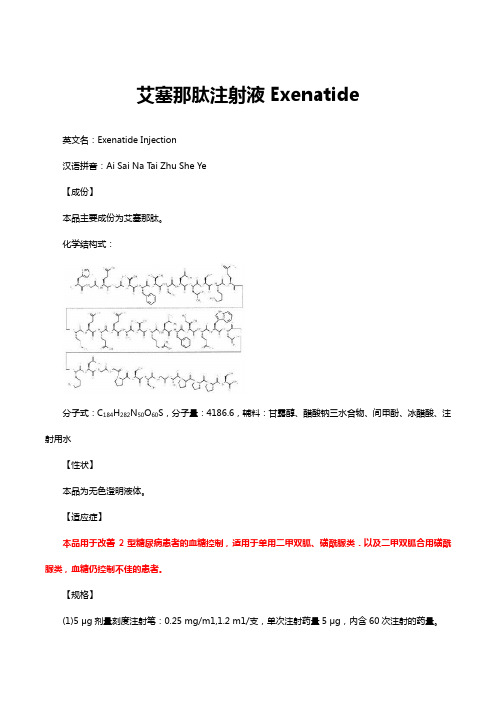
艾塞那肽注射液Exenatide英文名:Exenatide Injection汉语拼音:Ai Sai Na T ai Zhu She Ye【成份】本品主要成份为艾塞那肽。
化学结构式:分子式:C184H282N50O60S,分子量:4186.6,辅料:甘露醇、醋酸钠三水合物、间甲酚、冰醋酸、注射用水【性状】本品为无色澄明液体。
【适应症】本品用于改善2型糖尿病患者的血糖控制,适用于单用二甲双胍、磺酰脲类.以及二甲双胍合用磺酰脲类,血糖仍控制不佳的患者。
【规格】(1)5 μg剂量刻度注射笔:0.25 mg/m1,1.2 m1/支,单次注射药量5 μg,内含60次注射的药量。
(2)10 μg剂量刻度注射笔:0.25 mg/m1,2.4 m1/支,单次注射药量10 μg.内含60次注射的药量【用法用量】本品的起始剂量为每次5微克(μg),每日二次,在早餐和晚餐前60分钟内(或每天的2顿主餐前;给药间隔大约6小时或更长)皮下注射。
不应在餐后注射本品。
根据临床应答,在治疗1个月后剂量可增加至每次10微克,每日二次。
每次给药应在人腿、腹部或上臂皮下注射。
本品推荐用于接受二甲双胍、一种磺酰脲类、二甲双胍合用一种磺酰脲类治疗,血糖仍控制不佳的2型糖尿病患者。
在二甲双胍治疗的基础上加用本品时,可继续使用二甲双胍的目前剂量,因为合用本品发生低血糖而需要调整二甲双胍剂量的可能性较低。
在磺酰脲类治疗基础上加用本品时,应该考虑降低磺酰脲类的剂量,以降低低血糖发生的风险(参见【注意事项】,低血糖)。
本品为无色澄明液体,当溶液有颗粒、浑浊或变色时不得使用。
过有效期后不得使用。
尚无本品静脉或肌肉注射的安全性和有效性资料。
注射笔使用指南注射笔的详细操作图示和注射指导请参见本品包装盒中所附“注射笔使用手册”。
重要提示使用本注射笔前请仔细阅读“注射笔使用手册”,如果不完全按照使用手册操作可能会出现剂量错误、注射笔损坏或者发生感染。
·每次使用前请检查注射笔上的标签,确认其为自已所用的5μg或10μg注射笔。
艾塞那肽注射液治疗老年2型糖尿病病人的观察及护理
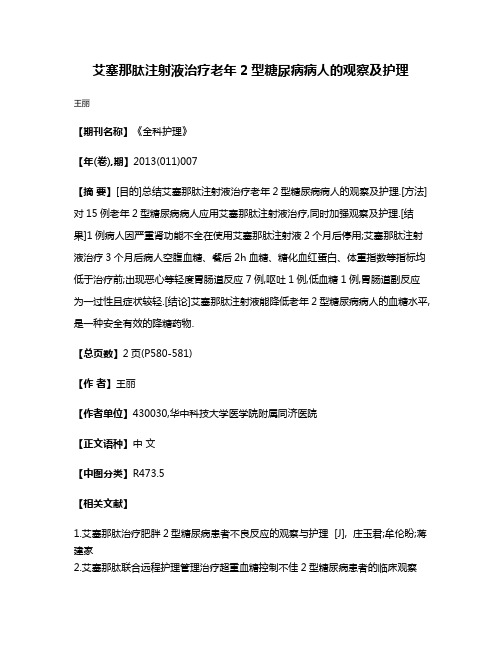
艾塞那肽注射液治疗老年2型糖尿病病人的观察及护理
王丽
【期刊名称】《全科护理》
【年(卷),期】2013(011)007
【摘要】[目的]总结艾塞那肽注射液治疗老年2型糖尿病病人的观察及护理.[方法]对15例老年2型糖尿病病人应用艾塞那肽注射液治疗,同时加强观察及护理.[结果]1例病人因严重肾功能不全在使用艾塞那肽注射液2个月后停用;艾塞那肽注射液治疗3个月后病人空腹血糖、餐后2h血糖、糖化血红蛋白、体重指数等指标均低于治疗前;出现恶心等轻度胃肠道反应7例,呕吐1例,低血糖1例,胃肠道副反应为一过性且症状较轻.[结论]艾塞那肽注射液能降低老年2型糖尿病病人的血糖水平,是一种安全有效的降糖药物.
【总页数】2页(P580-581)
【作者】王丽
【作者单位】430030,华中科技大学医学院附属同济医院
【正文语种】中文
【中图分类】R473.5
【相关文献】
1.艾塞那肽治疗肥胖2型糖尿病患者不良反应的观察与护理 [J], 庄玉君;牟伦盼;蒋建家
2.艾塞那肽联合远程护理管理治疗超重血糖控制不佳2型糖尿病患者的临床观察
[J], 梁红霞;李放
3.艾塞那肽注射液治疗超重2型糖尿病临床疗效观察 [J], 郑伟
4.消脂汤联合艾塞那肽注射液治疗2型糖尿病合并肥胖的临床疗效 [J], 胡仙;任汐
5.艾塞那肽联合二甲双胍治疗老年2型糖尿病临床观察 [J], 潘娜娜
因版权原因,仅展示原文概要,查看原文内容请购买。
艾塞那肽减肥
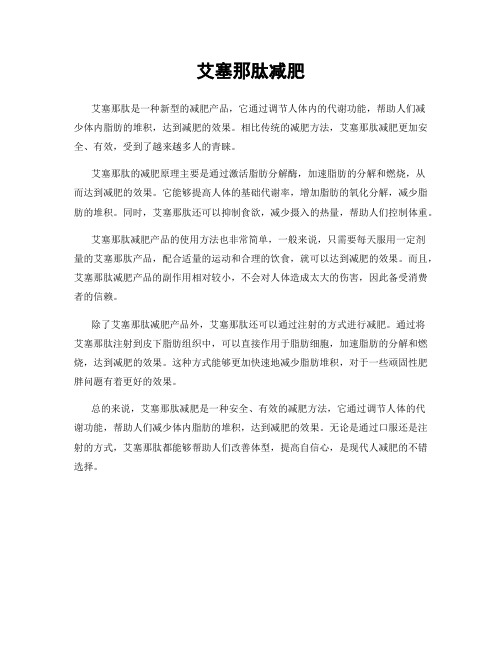
艾塞那肽减肥
艾塞那肽是一种新型的减肥产品,它通过调节人体内的代谢功能,帮助人们减
少体内脂肪的堆积,达到减肥的效果。
相比传统的减肥方法,艾塞那肽减肥更加安全、有效,受到了越来越多人的青睐。
艾塞那肽的减肥原理主要是通过激活脂肪分解酶,加速脂肪的分解和燃烧,从
而达到减肥的效果。
它能够提高人体的基础代谢率,增加脂肪的氧化分解,减少脂肪的堆积。
同时,艾塞那肽还可以抑制食欲,减少摄入的热量,帮助人们控制体重。
艾塞那肽减肥产品的使用方法也非常简单,一般来说,只需要每天服用一定剂
量的艾塞那肽产品,配合适量的运动和合理的饮食,就可以达到减肥的效果。
而且,艾塞那肽减肥产品的副作用相对较小,不会对人体造成太大的伤害,因此备受消费者的信赖。
除了艾塞那肽减肥产品外,艾塞那肽还可以通过注射的方式进行减肥。
通过将
艾塞那肽注射到皮下脂肪组织中,可以直接作用于脂肪细胞,加速脂肪的分解和燃烧,达到减肥的效果。
这种方式能够更加快速地减少脂肪堆积,对于一些顽固性肥胖问题有着更好的效果。
总的来说,艾塞那肽减肥是一种安全、有效的减肥方法,它通过调节人体的代
谢功能,帮助人们减少体内脂肪的堆积,达到减肥的效果。
无论是通过口服还是注射的方式,艾塞那肽都能够帮助人们改善体型,提高自信心,是现代人减肥的不错选择。
艾塞那肽FDA说明书

HIGHLIGHTS OF PRESCRIBING INFORMATIONThese highlights do not include all the information needed to use BYETTA safely and effectively. See full prescribing information for BYETTA.BYETTA® (exenatide) InjectionInitial U.S. Approval: 2005--------------------------RECENT MAJOR CHANGES------------------------Indications and Usage 10/2009Monotherapy and Combination Therapy (1.1)Important Limitations of Use 10/2009History of Pancreatitis (1.2)Warnings and Precautions 10/2009Pancreatitis (5.1)Renal Impairment (5.3)Macrovascular Outcomes (5.7)---------------------------INDICATIONS AND USAGE--------------------------- BYETTA is a glucagon-like peptide-1 (GLP-1) receptor agonist indicated as an adjunct to diet and exercise to improve glycemic control in adults with type 2 diabetes mellitus.Important Limitations of Use• BYETTA is not a substitute for insulin. BYETTA should not be used in patients with type 1 diabetes or for the treatment of diabetic ketoacidosis(1.2).• The concurrent use of BYETTA with insulin has not been studied and cannot be recommended (1.2).• BYETTA has not been studied in patients with a history of pancreatitis.Consider other antidiabetic therapies in patients with a history ofpancreatitis (1.2).-------------------------DOSAGE AND ADMINISTRATION------------------- • Inject subcutaneously within 60 minutes prior to morning and evening meals (or before the two main meals of the day, approximately 6 hours or more apart) (2.1).• Initiate at 5 mcg per dose twice daily; increase to 10 mcg twice daily after 1 month based on clinical response (2.1).------------------------DOSAGE FORMS AND STRENGTHS------------------- BYETTA is supplied as 250 mcg/mL exenatide in:• 5 mcg per dose, 60 doses, 1.2 mL prefilled pen• 10 mcg per dose, 60 doses, 2.4 mL prefilled pen-----------------------------CONTRAINDICATIONS------------------------------ • History of severe hypersensitivity to exenatide or any product components(4.1).-----------------------WARNINGS AND PRECAUTIONS----------------------- • Pancreatitis: Postmarketing reports, including fatal and non-fatal hemorrhagic or necrotizing pancreatitis. Discontinue BYETTA promptly.FULL PRESCRIBING INFORMATION: CONTENTS*1 INDICATIONS AND USAGE1.1 Type 2 Diabetes Mellitus1.2 Important Limitations of Use2 DOSAGE AND ADMINISTRATION2.1 Recommended Dosing3 DOSAGE FORMS AND STRENGTHS4 CONTRAINDICATIONS4.1 Hypersensitivity5 WARNINGS AND PRECAUTIONS5.1 Acute Pancreatitis5.2 Hypoglycemia5.3 Renal Impairment5.4 Gastrointestinal Disease5.5 Immunogenicity5.6 Hypersensitivity5.7 Macrovascular Outcomes6 ADVERSE REACTIONS6.1 Clinical Trial Experience6.2 Post-Marketing Experience7 DRUG INTERACTIONS7.1 Orally Administered Drugs7.2 Warfarin8 USE IN SPECIFIC POPULATIONS8.1 Pregnancy8.3 Nursing MothersBYETTA should not be restarted. Consider other antidiabetic therapies in patients with a history of pancreatitis (5.1).• Hypoglycemia: Increased risk when BYETTA is used in combination witha sulfonylurea. Consider reducing the sulfonylurea dose (5.2).• Renal Impairment: Postmarketing reports, sometimes requiring hemodialysis and kidney transplantation. BYETTA should not be used in patients with severe renal impairment or end-stage renal disease and should be used with caution in patients with renal transplantation. Caution should be applied when initiating BYETTA or escalating the dose of BYETTA in patients with moderate renal failure (5.3).• Severe Gastrointestinal Disease: Use of BYETTA is not recommended in patients with severe gastrointestinal disease (e.g., gastroparesis) (5.4). • Hypersensitivity: Postmarketing reports of hypersensitivity reactions (e.g.anaphylaxis and angioedema). The patient should discontinue BYETTA and other suspect medications and promptly seek medical advice (5.6). • There have been no clinical studies establishing conclusive evidence of macrovascular risk reduction with BYETTA or any other antidiabetic drug(5.7).-----------------------------ADVERSE REACTIONS------------------------------- • Most common (≥5%) and occurring more frequently than placebo in clinical trials: nausea, hypoglycemia, vomiting, diarrhea, feeling jittery, dizziness, headache, dyspepsia. Nausea usually decreases over time (5.2;6).• Postmarketing reports of increased international normalized ratio (INR) with concomitant use of warfarin, sometimes with bleeding (6.2).To report SUSPECTED ADVERSE REACTIONS contact Amylin Pharmaceuticals, Inc. and Eli Lilly and Company at 1-800-868-1190 and or FDA at 1-800-FDA-1088 or /medwatch ------------------------------DRUG INTERACTIONS------------------------------ • Warfarin: Postmarketing reports of increased INR sometimes associated with bleeding. Monitor INR frequently until stable upon initiation oralteration of BYETTA therapy (7.2).-------------------------USE IN SPECIFIC POPULATIONS--------------------- • Pregnancy: Based on animal data, BYETTA may cause fetal harm.BYETTA should be used during pregnancy only if the potential benefit justifies the potential risk to the fetus. To report drug exposure duringpregnancy call 1-800-633-9081 (8.1).• Nursing Mothers: Caution should be exercised when BYETTA is administered to a nursing woman (8.3).See 17 for PATIENT COUNSELING INFORMATION and FDA-approved patient labeling.Revised: 10/20098.4 Pediatric Use8.5 Geriatric Use8.6 Renal Impairment8.7 Hepatic Impairment10 OVERDOSAGE11 DESCRIPTION12 CLINICAL PHARMACOLOGY12.1 Mechanism of Action12.2 Pharmacodynamics12.3 Pharmacokinetics13 NONCLINICAL TOXICOLOGY13.1 Carcinogenesis, Mutagenesis, Impairment ofFertility13.3 Reproductive and Developmental Toxicology14 CLINICAL STUDIES14.1 Monotherapy14.2 Combination Therapy16 HOW SUPPLIED/STORAGE AND HANDLING16.1 How Supplied16.2 Storage and Handling17 PATIENT COUNSELING INFORMATION* Sections or subsections omitted from the full prescribing information are not listed.FULL PRESCRIBING INFORMATION1 INDICATIONS AND USAGE1.1 Type 2 Diabetes MellitusBYETTA is indicated as an adjunct to diet and exercise to improve glycemic control in adults with type 2 diabetes mellitus.1.2 Important Limitations of UseBYETTA is not a substitute for insulin. BYETTA should not be used in patients with type 1 diabetes or for the treatment of diabetic ketoacidosis, as it would not be effective in these settings.The concurrent use of BYETTA with insulin has not been studied and cannot be recommended.Based on postmarketing data BYETTA has been associated with acute pancreatitis, including fatal and non-fatal hemorrhagic or necrotizing pancreatitis. BYETTA has not been studied in patients with a history of pancreatitis. It is unknown whether patients with a history of pancreatitis are at increased risk for pancreatitis while using BYETTA. Other antidiabetic therapies should be considered in patients with a history of pancreatitis.2 DOSAGE AND ADMINISTRATION2.1 Recommended DosingBYETTA should be initiated at 5 mcg administered twice daily at any time within the 60-minute period before the morning and evening meals (or before the two main meals of the day, approximately 6 hours or more apart). BYETTA should not be administered after a meal. Based on clinical response, the dose of BYETTA can be increased to 10 mcg twice daily after 1 month of therapy. Initiation with 5 mcg reduces the incidence and severity of gastrointestinal side effects. Each dose should be administered as a subcutaneous (SC) injection in the thigh, abdomen, or upper arm. No data are available on the safety or efficacy of intravenous or intramuscular injection of BYETTA.Use BYETTA only if it is clear, colorless and contains no particles.3 DOSAGE FORMS AND STRENGTHSBYETTA is supplied as a sterile solution for subcutaneous injection containing 250 mcg/mL exenatide in the following packages:• 5 mcg per dose, 60 doses, 1.2 mL prefilled pen• 10 mcg per dose, 60 doses, 2.4 mL prefilled peni p i a 4 CONTRAINDICATIONS4.1 HypersensitivityBYETTA is contraindicated in patients with prior severe hypersensitivity reactions to exenatide or to any of the product components.5 WARNINGS AND PRECAUTIONS5.1 Acute PancreatitisBased on postmarketing data BYETTA has been associated with acute pancreatitis,ncluding fatal and non-fatal hemorrhagic or necrotizing pancreatitis. After initiation ofBYETTA, and after dose increases, observe patients carefully for signs and symptoms ofancreatitis (including persistent severe abdominal pain, sometimes radiating to the back, which may or may not be accompanied by vomiting). If pancreatitis is suspected,BYETTA should promptly be discontinued and appropriate management should benitiated. If pancreatitis is confirmed, BYETTA should not be restarted. Considerntidiabetic therapies other than BYETTA in patients with a history of pancreatitis.5.2 HypoglycemiaThe risk of hypoglycemia is increased when BYETTA is used in combination with asulfonylurea (hypoglycemia can also occur when other antidiabetic agents are used incombination with a sulfonylurea). Therefore, patients receiving BYETTA and a sulfonylureamay require a lower dose of the sulfonylurea to reduce the risk of hypoglycemia. It is alsopossible that the use of BYETTA with other glucose-independent insulin secretagogues (e.g.meglitinides) could increase the risk of hypoglycemia.For additional information on glucose dependent effects see Mechanism of Action (12.1).5.3 Renal ImpairmentBYETTA should not be used in patients with severe renal impairment (creatinine clearance< 30 mL/min) or end-stage renal disease and should be used with caution in patients with renaltransplantation [see Use in Specific Populations (8.6)]. In patients with end-stage renal disease receiving dialysis, single doses of BYETTA 5 mcg were not well-tolerated due to gastrointestinal side effects. Because BYETTA may induce nausea and vomiting with transient hypovolemia,treatment may worsen renal function. Caution should be applied when initiating or escalatingdoses of BYETTA from 5 mcg to 10 mcg in patients with moderate renal impairment (creatinine clearance 30 to 50 mL/min).There have been postmarketing reports of altered renal function, including increased serumcreatinine, renal impairment, worsened chronic renal failure and acute renal failure, sometimesrequiring hemodialysis or kidney transplantation. Some of these events occurred in patientsreceiving one or more pharmacologic agents known to affect renal function or hydration status, such as angiotensin converting enzyme inhibitors, nonsteroidal anti-inflammatory drugs, or diuretics. Some events occurred in patients who had been experiencing nausea, vomiting, or diarrhea, with or without dehydration. Reversibility of altered renal function has been observed in many cases with supportive treatment and discontinuation of potentially causative agents, including BYETTA. Exenatide has not been found to be directly nephrotoxic in preclinical or clinical studies.5.4 Gastrointestinal DiseaseBYETTA has not been studied in patients with severe gastrointestinal disease, including gastroparesis. Because BYETTA is commonly associated with gastrointestinal adverse reactions, including nausea, vomiting, and diarrhea, the use of BYETTA is not recommended in patients with severe gastrointestinal disease.5.5 ImmunogenicityPatients may develop antibodies to exenatide following treatment with BYETTA, consistent with the potentially immunogenic properties of protein and peptide pharmaceuticals. In a small proportion of patients, the formation of antibodies to exenatide at high titers could result in failure to achieve adequate improvement in glycemic control. If there is worsening glycemic control or failure to achieve targeted glycemic control, alternative antidiabetic therapy should be considered [see Adverse Reactions (6.1)].5.6 HypersensitivityThere have been postmarketing reports of serious hypersensitivity reactions (e.g. anaphylaxis and angioedema) in patients treated with BYETTA. If a hypersensitivity reaction occurs, the patient should discontinue BYETTA and other suspect medications and promptly seek medical advice [see Adverse Reactions (6.2)].5.7 Macrovascular OutcomesThere have been no clinical studies establishing conclusive evidence of macrovascular risk reduction with BYETTA or any other antidiabetic drug.6 ADVERSE REACTIONS6.1 Clinical Trial ExperienceBecause clinical trials are conducted under widely varying conditions, adverse reaction rates observed in the clinical trials of a drug cannot be directly compared to rates in the clinical trials of another drug and may not reflect the rates observed in practice.HypoglycemiaTable 1 summarizes the incidence and rate of hypoglycemia with BYETTA in five placebo-controlled clinical trials.Table 1: Incidence (%) and Rate of Hypoglycemia When BYETTA was Used as Monotherapy or WithConcomitant Antidiabetic Therapy in Five Placebo-Controlled Clinical Trials*BYETTAPlacebo twice daily 5 mcg twice daily 10 mcg twice dailyMonotherapy (24 Weeks)77 77 78N%1.3% 5.2% 3.8%OverallRate0.03 0.21 0.52 (episodes/patientyear)% Severe 0.0% 0.0% 0.0%With Metformin (30 Weeks)N 113 110 1135.3% 4.5% 5.3%Overall%Rate0.12 0.13 0.12 (episodes/patientyear)% Severe 0.0% 0.0% 0.0%With a Sulfonylurea (30 Weeks)N 123 125 129 % Overall 3.3% 14.4% 35.7%Rate0.07 0.64 1.61 (episodes/patientyear)% Severe 0.0% 0.0% 0.0%With Metformin and a Sulfonylurea (30 Weeks)N 247 245 241 % Overall 12.6% 19.2% 27.8%Rate0.58 0.78 1.71 (episodes/patientyear)% Severe 0.0% 0.4% 0.0%With a Thiazolidinedione (16 Weeks)N 112 Dose not studied 121% Overall 7.1% Dose not studied 10.7%Rate0.56 Dose not studied 0.98(episodes/patientyears)% Severe 0.0% Dose not studied 0.0%* For the 30-week trials, a hypoglycemia episode was recorded if the patient reported symptoms consistent with hypoglycemia and was recorded as severe if the subject required the assistance of another person to treat theevent. For the other trials, a hypoglycemic episode was recorded if a patient reported signs or symptoms ofhypoglycemia or had a blood glucose value consistent with hypoglycemia regardless of associated symptoms ortreatment and was recorded as severe if the subject required the assistance of another person to treat the event.The requirement for assistance had to be accompanied by a blood glucose measurement of <50 mg/dL orprompt recovery after administration of oral carbohydrate.N = The number of Intent-to-Treat subjects in each treatment group.Immunogenicitypatients had low titer antibodies to exenatide at 30 weeks. For this group, the level of glycemic control (hemoglobin A1c [HbA1c]) was generally comparable to that observed in those without antibody titers. An additional 6% of patients had higher titer antibodies at 30 weeks. In about half of this 6% (3% of the total patients given BYETTA in the 30-week controlled studies), the glycemic response to BYETTA was attenuated; the remainder had a glycemic response comparable to that of patients without antibodies.In the 16-week trial of BYETTA add-on to thiazolidinediones, with or without metformin, 9% of patients had higher titer antibodies at 16 weeks. In the 24-week trial of BYETTA used as monotherapy, 3% of patients had higher titer antibodies at 24 weeks. Compared with patients who did not develop antibodies to BYETTA, on average the glycemic response in patients with higher titer antibodies was attenuated [see Warnings and Precautions (5.5)].Other Adverse ReactionsMonotherapyFor the 24-week placebo-controlled study of BYETTA used as a monotherapy, Table 2 summarizes adverse reactions (excluding hypoglycemia) occurring with an incidence ≥2% and occurring more frequently in BYETTA-treated patients compared with placebo-treated patients. Table 2: Treatment-Emergent Adverse Reactions ≥2% Incidence With BYETTA Used as Monotherapy (Excluding Hypoglycemia)*Monotherapy Placebo BIDN = 77%All BYETTA BIDN = 155%Nausea 0 8Vomiting 0 4Dyspepsia 0 3 * In a 24-week placebo-controlled trial.BID = twice daily.Adverse reactions reported in ≥1.0 to <2.0% of patients receiving BYETTA and reported more frequently than with placebo included decreased appetite, diarrhea, and dizziness. The most frequently reported adverse reaction associated with BYETTA, nausea, occurred in a dose-dependent fashion.Two of the 155 patients treated with BYETTA withdrew due to adverse reactions of headache and nausea. No placebo-treated patients withdrew due to adverse reactions.Combination TherapyAdd-on to metformin and/or sulfonylureaadverse reactions (excluding hypoglycemia) with an incidence ≥2% and occurring more frequently in BYETTA-treated patients compared with placebo-treated patients [see Warnings and Precautions (5.2)] are summarized in Table 3.Table 3: Treatment-Emergent Adverse Reactions ≥2% Incidence and Greater Incidence With BYETTA Treatment Used With Metformin and/or a Sulfonylurea (Excluding Hypoglycemia)*Placebo BID N = 483% All BYETTA BIDN = 963%Nausea 18 44Vomiting 4 13Diarrhea 6 13 Feeling Jittery 4 9Dizziness 6 9Headache 6 9Dyspepsia 3 6Asthenia 2 4 Gastroesophageal RefluxDisease1 3Hyperhidrosis 1 3 * In three 30-week placebo-controlled clinical trials.BID = twice daily.Adverse reactions reported in ≥1.0 to <2.0% of patients receiving BYETTA and reported morefrequently than with placebo included decreased appetite. Nausea was the most frequentlyreported adverse reaction and occurred in a dose-dependent fashion. With continued therapy, the frequency and severity decreased over time in most of the patients who initially experiencednausea. Patients in the long-term uncontrolled open-label extension studies at 52 weeks reportedno new types of adverse reactions than those observed in the 30-week controlled trials.The most common adverse reactions leading to withdrawal for BYETTA-treated patients werenausea (3% of patients) and vomiting (1%). For placebo-treated patients, <1% withdrew due tonausea and none due to vomiting.Add-on to thiazolidinedione with or without metforminFor the 16-week placebo-controlled study of BYETTA add-on to a thiazolidinedione, with orwithout metformin, Table 4 summarizes the adverse reactions (excluding hypoglycemia) with an incidence of ≥2% and occurring more frequently in BYETTA-treated patients compared withplacebo-treated patients.Table 4: Treatment-Emergent Adverse Reactions ≥2% Incidence With BYETTA Used With a Thiazolidinedione, With or Without Metformin (Excluding Hypoglycemia)*With a TZD or TZD/MET PlaceboN = 112%All BYETTA BIDN = 121%Nausea 15 40Vomiting 1 13Dyspepsia 1 7Diarrhea 3 6 GastroesophagealReflux Disease0 3* In a 16-week placebo-controlled clinical trial.BID = twice daily.Adverse reactions reported in ≥1.0 to <2.0% of patients receiving BYETTA and reported more frequently than with placebo included decreased appetite. Chills (n = 4) and injection-sitereactions (n = 2) occurred only in BYETTA-treated patients. The two patients who reported an injection-site reaction had high titers of antibodies to exenatide. Two serious adverse events(chest pain and chronic hypersensitivity pneumonitis) were reported in the BYETTA arm. Noserious adverse events were reported in the placebo arm.The most common adverse reactions leading to withdrawal for BYETTA-treated patients werenausea (9%) and vomiting (5%). For placebo-treated patients, <1% withdrew due to nausea.6.2 Post-Marketing ExperienceThe following additional adverse reactions have been reported during post-approval use of BYETTA. Because these events are reported voluntarily from a population of uncertain size, itis generally not possible to reliably estimate their frequency or establish a causal relationship todrug exposure.Allergy/Hypersensitivity: injection-site reactions, generalized pruritus and/or urticaria, macularor papular rash, angioedema, anaphylactic reaction [see Warnings and Precautions (5.6)].Drug Interactions: International normalized ratio (INR) increased with concomitant warfarin use sometimes associated with bleeding [see Drug Interactions (7.2)].Gastrointestinal: nausea, vomiting, and/or diarrhea resulting in dehydration; abdominaldistension, abdominal pain, eructation, constipation, flatulence, acute pancreatitis, hemorrhagicand necrotizing pancreatitis sometimes resulting in death [see Limitations of Use (1.2) andWarnings and Precautions (5.1)].Neurologic: dysgeusia; somnolenceRenal and Urinary Disorders: altered renal function, including increased serum creatinine, renal impairment, worsened chronic renal failure or acute renal failure (sometimes requiringhemodialysis), kidney transplant and kidney transplant dysfunction [see Warnings and Precautions (5.3)].7 DRUG INTERACTIONS7.1 Orally Administered DrugsThe effect of BYETTA to slow gastric emptying can reduce the extent and rate of absorption of orally administered drugs. BYETTA should be used with caution in patients receiving oral medications that have narrow therapeutic index or require rapid gastrointestinal absorption [see Adverse Reactions (6.2)]. For oral medications that are dependent on threshold concentrations for efficacy, such as contraceptives and antibiotics, patients should be advised to take those drugs at least 1 hour before BYETTA injection. If such drugs are to be administered with food, patients should be advised to take them with a meal or snack when BYETTA is not administered [see Clinical Pharmacology (12.3)].7.2 WarfarinThere are postmarketing reports of increased INR sometimes associated with bleeding, with concomitant use of warfarin and BYETTA [see Adverse Reactions (6.2)]. In a drug interaction study, BYETTA did not have a significant effect on INR [see Clinical Pharmacology (12.3)]. In patients taking warfarin, prothrombin time should be monitored more frequently after initiation or alteration of BYETTA therapy. Once a stable prothrombin time has been documented, prothrombin times can be monitored at the intervals usually recommended for patients on warfarin.8 USE IN SPECIFIC POPULATIONS8.1 PregnancyPregnancy Category CThere are no adequate and well-controlled studies of BYETTA use in pregnant women. In animal studies, exenatide caused cleft palate, irregular skeletal ossification and an increased number of neonatal deaths. BYETTA should be used during pregnancy only if the potential benefit justifies the potential risk to the fetus.Female mice given SC doses of 6, 68, or 760 mcg/kg/day beginning 2 weeks prior to and throughout mating until gestation day 7 had no adverse fetal effects. At the maximal dose,760 mcg/kg/day, systemic exposures were up to 390 times the human exposure resulting from the maximum recommended dose of 20 mcg/day, based on AUC [see Nonclinical Toxicology (13.3)].In developmental toxicity studies, pregnant animals received exenatide subcutaneously during organogenesis. Specifically, fetuses from pregnant rabbits given SC doses of 0.2, 2, 22, 156, or260 mcg/kg/day from gestation day 6 through 18 experienced irregular skeletal ossifications from exposures 12 times the human exposure resulting from the maximum recommended dose of 20 mcg/day, based on AUC. Moreover, fetuses from pregnant mice given SC doses of 6, 68, 460, or 760 mcg/kg/day from gestation day 6 through 15 demonstrated reduced fetal and neonatal growth, cleft palate and skeletal effects at systemic exposure 3 times the human exposure resulting from the maximum recommended dose of 20 mcg/day, based on AUC [see Nonclinical Toxicology (13.3)].Lactating mice given SC doses of 6, 68, or 760 mcg/kg/day from gestation day 6 through lactation day 20 (weaning), experienced an increased number of neonatal deaths. Deaths were observed on postpartum days 2-4 in dams given 6 mcg/kg/day, a systemic exposure 3 times the human exposure resulting from the maximum recommended dose of 20 mcg/day, based on AUC [see Nonclinical Toxicology (13.3)].Pregnancy RegistryAmylin Pharmaceuticals, Inc. maintains a Pregnancy Registry to monitor pregnancy outcomes of women exposed to exenatide during pregnancy. Physicians are encouraged to register patients by calling 1-800-633-9081.8.3 Nursing MothersIt is not known whether exenatide is excreted in human milk. However, exenatide is present at low concentrations (less than or equal to 2.5% of the concentration in maternal plasma following subcutaneous dosing) in the milk of lactating mice. Many drugs are excreted in human milk and because of the potential for clinically significant adverse reactions in nursing infants from exenatide, a decision should be made whether to discontinue nursing or discontinue the drug, taking into account these potential risks against the glycemic benefits to the lactating woman. Caution should be exercised when BYETTA is administered to a nursing woman.8.4 Pediatric UseSafety and effectiveness of BYETTA have not been established in pediatric patients.8.5 Geriatric UsePopulation pharmacokinetic analysis of patients ranging from 22 to 73 years of age suggests that age does not influence the pharmacokinetic properties of exenatide [see Clinical Pharmacology (12.3)]. BYETTA was studied in 282 patients 65 years of age or older and in 16 patients75 years of age or older. No differences in safety or effectiveness were observed between these patients and younger patients. Because elderly patients are more likely to have decreased renal function, care should be taken in dose selection in the elderly based on renal function.8.6 Renal ImpairmentBYETTA is not recommended for use in patients with end-stage renal disease or severe renal impairment (creatinine clearance < 30 mL/min) and should be used with caution in patients with renal transplantation. No dosage adjustment of BYETTA is required in patients with mild renal impairment (creatinine clearance 50 to 80 mL/min). Caution should be applied when initiating or escalating doses of BYETTA from 5 mcg to 10 mcg in patients with moderate renal impairment (creatinine clearance 30 to 50 mL/min) [see Clinical Pharmacology (12.3)].8.7 Hepatic ImpairmentNo pharmacokinetic study has been performed in patients with a diagnosis of acute or chronic hepatic impairment. Because exenatide is cleared primarily by the kidney, hepatic dysfunction is not expected to affect blood concentrations of exenatide [see Clinical Pharmacology (12.3)].10 OVERDOSAGEIn a clinical study of BYETTA, three patients with type 2 diabetes each experienced a single overdose of 100 mcg SC (10 times the maximum recommended dose). Effects of the overdoses included severe nausea, severe vomiting, and rapidly declining blood glucose concentrations. One of the three patients experienced severe hypoglycemia requiring parenteral glucose administration. The three patients recovered without complication. In the event of overdose, appropriate supportive treatment should be initiated according to the patient’s clinical signs and symptoms.11 DESCRIPTIONBYETTA (exenatide) is a synthetic peptide that was originally identified in the lizard Heloderma suspectum. Exenatide differs in chemical structure and pharmacological action from insulin, sulfonylureas (including D-phenylalanine derivatives and meglitinides), biguanides, thiazolidinediones, alpha-glucosidase inhibitors, amylinomimetics and dipeptidyl peptidase-4 inhibitors.Exenatide is a 39-amino acid peptide amide. Exenatide has the empirical formulaC184H282N50O60S and molecular weight of 4186.6 Daltons. The amino acid sequence for exenatide is shown below.H-His-Gly-Glu-Gly-Thr-Phe-Thr-Ser-Asp-Leu-Ser-Lys-Gln-Met-Glu-Glu-Glu-Ala-Val-Arg-Leu -Phe-Ile-Glu-Trp-Leu-Lys-Asn-Gly-Gly-Pro-Ser-Ser-Gly-Ala-Pro-Pro-Pro-Ser-NH2BYETTA is supplied for SC injection as a sterile, preserved isotonic solution in a glass cartridge that has been assembled in a pen-injector (pen). Each milliliter (mL) contains 250 micrograms (mcg) synthetic exenatide, 2.2 mg metacresol as an antimicrobial preservative, mannitol as a tonicity-adjusting agent, and glacial acetic acid and sodium acetate trihydrate in water for。
艾塞那肽缓释制剂说明书

百达扬说明书

百达扬说明书 Prepared on 22 November 2020【药品名称】商品名称:百达扬通用名称:注射用艾塞那肽微球英文名称:Exenatide Microspheres for Injection【成份】注射用艾塞那肽微球活性成份为艾塞那肽。
辅料:注射用艾塞那肽微球:乙交酯丙交酯共聚物(50:50),蔗糖。
注射用溶剂:羧甲基纤维素钠、氯化钠、聚山梨酯20、磷酸二氢钠一水合物、磷酸氢二钠七水合物、注射用水。
【适应症】用于改善患者的血糖控制,适用于单用二甲双胍、磺脲类以及二甲双胍合用磺脲类血糖仍控制不佳的患者。
【用法用量】推荐用量注射用艾塞那肽微球(2mg)应每7天(每周)皮下注射一次。
可在一天中的任何时间注射,空腹或进食后均可。
漏用如漏用一次且距离下次预定用药至少3天以上,应在发现后尽快注射。
此后,患者可恢复其每7天(每周)一次的常规用药计划。
如漏用一次且距离下次预定用药1或2天,患者不应给予漏掉剂量而应在下次预定用药时按照常规计划注射。
改变每周用药方案如果有需要可改变每周的用药日,只要与上次注射至少间隔3天。
用法注射用艾塞那肽微球由患者自行给药,需要混合药物和填充注射器。
一旦将药物混合后,必须立即注射。
用药应在腹部、大腿或上臂区域皮下(SC)注射。
告知患者在同一区域注射时,每周选择不同的部位。
禁止静脉注射或肌肉注射。
给药前,患者应接受医疗专业人员的培训。
完整的用药说明(带图示)请参见注射用艾塞那肽微球的使用手册。
【不良反应】肾功能损害重度肾功能损害(肌酐清除率<30mL/min)或终末期肾病患者不应使用注射用艾塞那肽微球,在肾移植患者中应谨慎使用。
接受透析的终末期肾病患者,由于发生胃肠道不良反应,不能很好地耐受单剂量5μg塞那肽注射液。
由于注射用艾塞那肽微球可能引起恶心、呕吐伴一过性低血容量,故治疗可能造成肾功能损害加重。
中度肾功能损害患者(肌酐清除率30至50mL/min)使用注射用艾塞那肽微球时应谨慎。
艾塞那肽注射液治疗糖尿病的效果及用药不良反应率评价
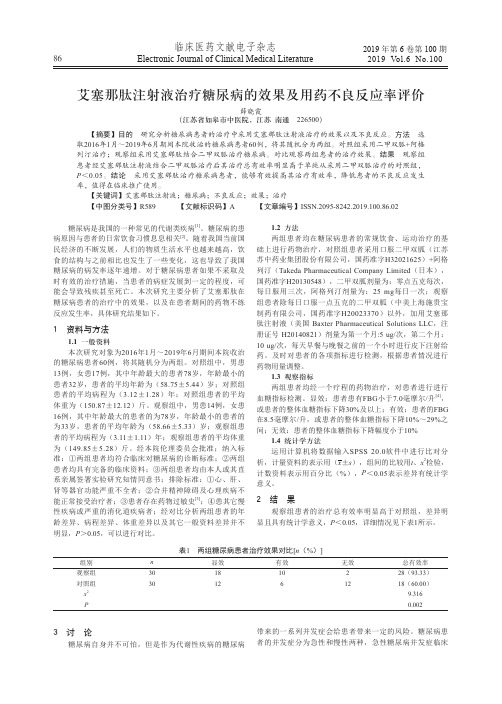
862019 年第 6 卷第 100 期2019 Vol.6 No.100临床医药文献电子杂志Electronic Journal of Clinical Medical Literature艾塞那肽注射液治疗糖尿病的效果及用药不良反应率评价薛晓霞(江苏省如皋市中医院,江苏 南通 226500)【摘要】目的 研究分析糖尿病患者的治疗中采用艾塞那肽注射液治疗的效果以及不良反应。
方法 选取2016年1月~2019年6月期间本院收治的糖尿病患者60例,将其随机分为两组。
对照组采用二甲双胍+阿格列汀治疗;观察组采用艾塞那肽结合二甲双胍治疗糖尿病。
对比观察两组患者的治疗效果。
结果 观察组患者经艾塞那肽注射液结合二甲双胍治疗后其治疗总有效率明显高于单纯从采用二甲双胍治疗的对照组, P <0.05。
结论 采用艾塞那肽治疗糖尿病患者,能够有效提高其治疗有效率,降低患者的不良反应发生率,值得在临床推广使用。
【关键词】艾塞那肽注射液;糖尿病;不良反应;效果;治疗【中图分类号】R589 【文献标识码】A 【文章编号】ISSN.2095-8242.2019.100.86.02糖尿病是我国的一种常见的代谢类疾病[1]。
糖尿病的患病原因与患者的日常饮食习惯息息相关[2]。
随着我国当前国民经济的不断发展,人们的物质生活水平也越来越高,饮食的结构与之前相比也发生了一些变化,这也导致了我国糖尿病的病发率逐年递增。
对于糖尿病患者如果不采取及时有效的治疗措施,当患者的病症发展到一定的程度,可能会导致残疾甚至死亡。
本次研究主要分析了艾塞那肽在糖尿病患者的治疗中的效果,以及在患者期间的药物不练反应发生率,具体研究结果如下。
1 资料与方法1.1 一般资料本次研究对象为2016年1月~2019年6月期间本院收治的糖尿病患者60例,将其随机分为两组。
对照组中,男患13例,女患17例,其中年龄最大的患者78岁,年龄最小的患者32岁,患者的平均年龄为(58.75±5.44)岁;对照组患者的平均病程为(3.12±1.28)年;对照组患者的平均体重为(150.87±12.12)斤。
艾塞那肽 Bydureon
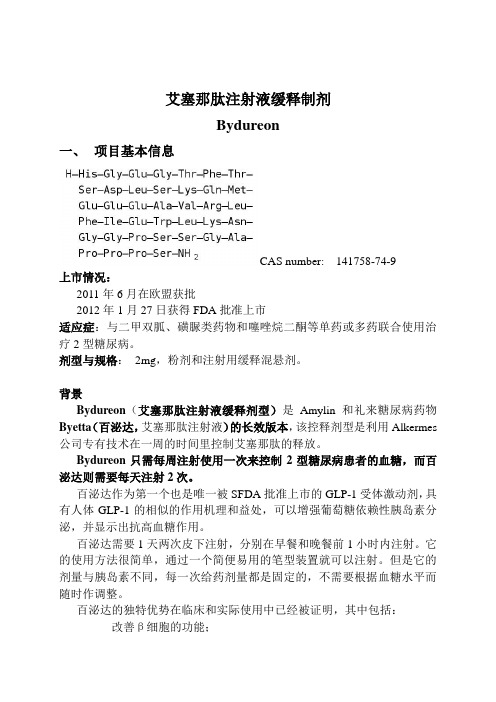
艾塞那肽注射液缓释制剂Bydureon一、项目基本信息CAS number: 141758-74-9上市情况:2011年6月在欧盟获批2012年1月27日获得FDA批准上市适应症:与二甲双胍、磺脲类药物和噻唑烷二酮等单药或多药联合使用治疗2型糖尿病。
剂型与规格:2mg,粉剂和注射用缓释混悬剂。
背景Bydureon(艾塞那肽注射液缓释剂型)是Amylin和礼来糖尿病药物Byetta(百泌达,艾塞那肽注射液)的长效版本,该控释剂型是利用Alkermes 公司专有技术在一周的时间里控制艾塞那肽的释放。
Bydureon只需每周注射使用一次来控制2型糖尿病患者的血糖,而百泌达则需要每天注射2次。
百泌达作为第一个也是唯一被SFDA批准上市的GLP-1受体激动剂,具有人体GLP-1的相似的作用机理和益处,可以增强葡萄糖依赖性胰岛素分泌,并显示出抗高血糖作用。
百泌达需要1天两次皮下注射,分别在早餐和晚餐前1小时内注射。
它的使用方法很简单,通过一个简便易用的笔型装置就可以注射。
但是它的剂量与胰岛素不同,每一次给药剂量都是固定的,不需要根据血糖水平而随时作调整。
百泌达的独特优势在临床和实际使用中已经被证明,其中包括:改善β细胞的功能;长期有效控制血糖,疗效卓越;葡萄糖依赖性的调控血糖,低血糖风险低;可降低患者体重;固定剂量,使用简单。
临床试验在长期试验中,Bydureon相对Byetta全面进行了24周的测试。
结果显示,使用Bydureon的患者改善了血糖控制,糖化血红蛋白指标与基线相比下降1.5%-1.9%,相比之下,使用Byetta 的患者只有0.9%。
此外,与使用Byetta具有相同的减轻体重作用。
主要的临床副反应是轻中度的恶心(与使用Byetta 的患者(35%)相比,使用Bydureon的患者(14%)更少出现该反应。
)、呕吐和腹泻,上呼吸道感染和注射部位结节,没有严重的低血糖事件。
中国目前约有2400万糖尿病患者,至2025年预计将达4613万。
百泌达(艾塞那肽注射液)说明书

坚持“专注于重大慢性疾病用药,持续改善患
者健康”的经营理念。
百济新特药房资深药师倾力制作千个药品专辑 安全、有效、合理用药之
百泌达篇
商品名:百泌达 厂家:Baxter Pharmaceutical Solutions LLC
【百泌达药品名称】 商品名称:百泌达 通用名称:艾塞那肽注射液 英文名称:Exenatide Injection 汉语拼音:AiSaiNaTaiZhuSheYe 【百泌达主要成分】艾塞那肽
【百泌达性状】 百泌达为无色透明液体。 【百泌达适应症】 适用于服用二甲双胍、磺脲类、噻唑烷二酮类、 二甲双胍和磺脲类联用、二甲双胍和噻唑烷二酮 类联用不能有效控制血糖的2型糖尿病患者的辅助 治疗以改善血糖控制。
【百泌达用法用量】 百泌达仅用于皮下注射。应在大腿、腹部或上臂皮 下注射给药。百泌达推荐起始剂量为5μg,每日两 次,于早餐和晚餐(或每日2次正餐前,大约间隔 6h或更长时间)前60分钟内给药。餐后不可给药。 治疗1个月后,可根据临床反应将剂量增加至10μg。 百泌达与二甲双胍或噻唑烷二酮类联用 时,如果联用后不会因低血糖而需调 整二甲双胍或噻唑烷二酮类的剂量, 则可继续沿用原二甲双胍或噻唑烷二 酮类的剂量。
【百济药师温馨提示】
百泌达禁忌:禁用于已知对艾塞那肽或百泌达其它成 份高度敏感的患者。
百泌达价格、优惠
请参考百济新特药房网药品信息
数十位资深药师
实时免费解答用药难题
了解百泌达
享受贴心的药学服务
历经十年,服务专业,提倡合理用药,提供 优质药品。
国内首家“全国连锁专科药房”,也是全国大
型的专科医药连锁企业之一。
【百泌达注意事项】 1、艾塞那肽注射液不是胰岛素的代替物,不应用于1 型糖尿病患者或糖尿病酮症酸中毒的治疗。 2、有使用艾塞那肽注射液治疗的患者发生急性胰腺炎 个案报道。应告知患者伴有呕吐的持续性、严重腹痛 是急性胰腺炎的标志性症状。如果怀疑发生急性胰腺 炎,应停用艾塞那肽注射液和其他可疑药物,并进行 确证试验和适当治疗。如果证实是胰腺 炎,但病因不明时,不推荐继续用艾塞 那肽注射液治疗。
艾塞那肽注射液说明书

核准日期:年月日艾塞那肽注射液说明书请仔细阅读说明书并在医师指导下使用对艾塞那肽及其它成份过敏者禁用【药物名称】通用名称:艾塞那肽注射液英文名称:Exenatide Injection汉语拼音:Aisainatai Zhusheye【成份】本品主要成份为艾塞那肽。
化学结构式:分子式:C184H282N50O60S分子量:4186.6辅料:甘露醇、醋酸钠三水合物、间甲酚(2.00-2.4mg/ml)、冰醋酸、注射用水。
【性状】本品为无色澄明液体【适应症】本品用于改善2型糖尿病患者的血糖控制,适用于单用二甲双胍、磺酰脲类,以及二甲双胍合用磺酰脲类,血糖仍控制不佳的患者。
【规格】(1)5μg剂量刻度注射笔:0.25 mg/ml,1.2 ml/支,单次注射药量5μg,内含60次注射的药量。
(2)10μg剂量刻度注射笔:0.25 mg/ml,2.4 ml/支,单次注射药量10μg,内含60次注射的药量。
【用法用量】本品的起始剂量为每次5微克(μg),每日2次,在早餐和晚餐前60分钟内(或每天的2顿主餐前;给药间隔大约6小时或更长)皮下注射。
不应在餐后注射本品。
根据临床应答,在治疗1个月后剂量可增加至10微克。
每日2次。
每次给药应在大腿、腹部或上臂皮下注射给药。
本品推荐用于接受二甲双胍、一种磺酰脲类、二甲双胍合用一种磺酰脲类治疗,血糖仍控制不佳的2型糖尿病患者。
在二甲双胍治疗的基础上加用本品时,可继续使用二甲双胍的目前剂量,因为合用本品发生低血糖而需要进行调整二甲双胍剂量的可能性较低。
在磺酰脲类治疗基础上加用本品,应该考虑降低磺酰脲类的剂量,以降低低血糖发生的风险。
(参照【注意事项】,低血糖)本品为无色澄明液体,当溶液有颗粒、浑浊或变色时不得使用。
过有效期后不得使用。
尚无本品静脉或肌肉注射的安全性和有效性资料。
注射笔使用指南注射笔的详细操作图示和注射指导请参见本品包装盒中所附“注射笔使用手册”。
重要提示使用本注射笔前请仔细阅读“注射笔使用手册”,如果不完全按照使用手册操作可能会出现剂量错误、注射笔损坏或者发生感染。
静脉注射的降糖药
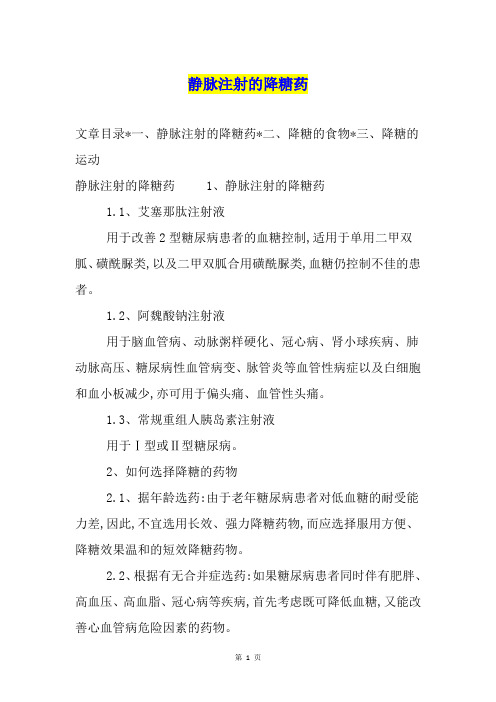
静脉注射的降糖药文章目录*一、静脉注射的降糖药*二、降糖的食物*三、降糖的运动静脉注射的降糖药 1、静脉注射的降糖药1.1、艾塞那肽注射液用于改善2型糖尿病患者的血糖控制,适用于单用二甲双胍、磺酰脲类,以及二甲双胍合用磺酰脲类,血糖仍控制不佳的患者。
1.2、阿魏酸钠注射液用于脑血管病、动脉粥样硬化、冠心病、肾小球疾病、肺动脉高压、糖尿病性血管病变、脉管炎等血管性病症以及白细胞和血小板减少,亦可用于偏头痛、血管性头痛。
1.3、常规重组人胰岛素注射液用于Ⅰ型或Ⅱ型糖尿病。
2、如何选择降糖的药物2.1、据年龄选药:由于老年糖尿病患者对低血糖的耐受能力差,因此,不宜选用长效、强力降糖药物,而应选择服用方便、降糖效果温和的短效降糖药物。
2.2、根据有无合并症选药:如果糖尿病患者同时伴有肥胖、高血压、高血脂、冠心病等疾病,首先考虑既可降低血糖,又能改善心血管病危险因素的药物。
2.3、根据糖尿病患者对服药的依从性选药:对于经常出差,进餐不规律的糖尿病患者,选择每天只需服药一次的药物更为方便适合。
3、降糖药选用误区3.1、对口服降糖药的特点不了解。
如一些磺脲类降糖药的药效随时间延长而逐渐增强,因此不能急于换药。
3.2、不定期复诊。
有的患者不监测血糖、血脂和血压,不注意观察影响自己血糖、尿糖变化的因素,不总结自己的服药规律,而是人云亦云,跟风吃药。
3.3、一味追求能“去根”的糖尿病特效药。
有的患者甚至在血糖已获得良好控制的情况下,停止现阶段有效治疗,而去寻找“灵丹妙药”。
降糖的食物 1、藕味甘,性寒。
适用于多饮仍烦渴不止、饥饿、形体消瘦型糖尿病,兼有吐血、衄血及热淋者尤为适宜。
2、萝卜味辛、甘,性温。
归肺、胃经。
适用于食积胀满型糖尿病。
3、韭菜味辛,性温。
入肝、胃、肾经。
适用于高血脂、冠心病、糖尿病患者。
4、山药能有效改善高血糖,山药中的黏滑成分能包裹肠内的其他食物,使糖分被缓慢地吸收。
5、芋头最适合需要限制热量的人,芋头中含有半乳聚糖,能有效降低血压和胆固醇。
艾塞那肽 Bydureon

艾塞那肽注射液缓释制剂Bydureon一、项目基本信息CAS number: 141758-74-9上市情况:2011年6月在欧盟获批2012年1月27日获得FDA批准上市适应症:与二甲双胍、磺脲类药物和噻唑烷二酮等单药或多药联合使用治疗2型糖尿病。
剂型与规格:2mg,粉剂和注射用缓释混悬剂。
背景Bydureon(艾塞那肽注射液缓释剂型)是Amylin和礼来糖尿病药物Byetta(百泌达,艾塞那肽注射液)的长效版本,该控释剂型是利用Alkermes 公司专有技术在一周的时间里控制艾塞那肽的释放。
Bydureon只需每周注射使用一次来控制2型糖尿病患者的血糖,而百泌达则需要每天注射2次。
百泌达作为第一个也是唯一被SFDA批准上市的GLP-1受体激动剂,具有人体GLP-1的相似的作用机理和益处,可以增强葡萄糖依赖性胰岛素分泌,并显示出抗高血糖作用。
百泌达需要1天两次皮下注射,分别在早餐和晚餐前1小时内注射。
它的使用方法很简单,通过一个简便易用的笔型装置就可以注射。
但是它的剂量与胰岛素不同,每一次给药剂量都是固定的,不需要根据血糖水平而随时作调整。
百泌达的独特优势在临床和实际使用中已经被证明,其中包括:改善β细胞的功能;长期有效控制血糖,疗效卓越;葡萄糖依赖性的调控血糖,低血糖风险低;可降低患者体重;固定剂量,使用简单。
临床试验在长期试验中,Bydureon相对Byetta全面进行了24周的测试。
结果显示,使用Bydureon的患者改善了血糖控制,糖化血红蛋白指标与基线相比下降1.5%-1.9%,相比之下,使用Byetta 的患者只有0.9%。
此外,与使用Byetta具有相同的减轻体重作用。
主要的临床副反应是轻中度的恶心(与使用Byetta 的患者(35%)相比,使用Bydureon的患者(14%)更少出现该反应。
)、呕吐和腹泻,上呼吸道感染和注射部位结节,没有严重的低血糖事件。
中国目前约有2400万糖尿病患者,至2025年预计将达4613万。
J-聚乙二醇洛塞那肽注射液 说明书
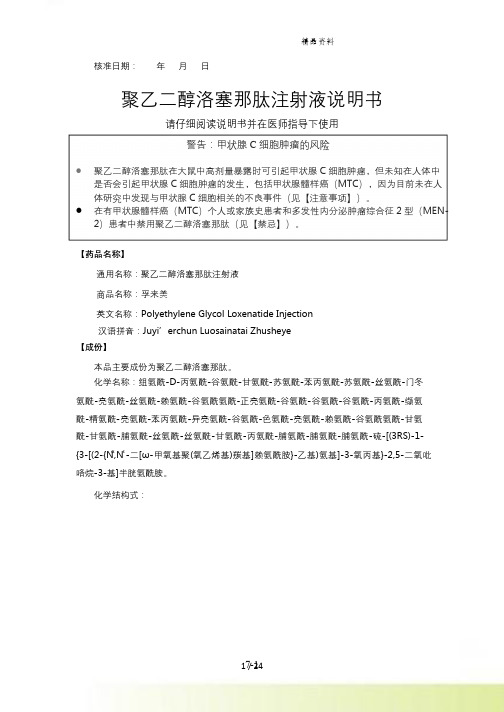
核准日期:年月日聚乙二醇洛塞那肽注射液说明书请仔细阅读说明书并在医师指导下使用警告:甲状腺 C 细胞肿瘤的风险● 聚乙二醇洛塞那肽在大鼠中高剂量暴露时可引起甲状腺C细胞肿瘤,但未知在人体中是否会引起甲状腺C细胞肿瘤的发生,包括甲状腺髓样癌(MTC),因为目前未在人体研究中发现与甲状腺C细胞相关的不良事件(见【注意事项】)。
在有甲状腺髓样癌(MTC)个人或家族史患者和多发性内分泌肿瘤综合征2型(MEN-●2)患者中禁用聚乙二醇洛塞那肽(见【禁忌】)。
【药品名称】通用名称:聚乙二醇洛塞那肽注射液商品名称:孚来美英文名称:Polyethylene Glycol Loxenatide Injection汉语拼音:Juyi’erchun Luosainatai Zhusheye【成份】本品主要成份为聚乙二醇洛塞那肽。
化学名称:组氨酰-D-丙氨酰-谷氨酰-甘氨酰-苏氨酰-苯丙氨酰-苏氨酰-丝氨酰-门冬氨酰-亮氨酰-丝氨酰-赖氨酰-谷氨酰氨酰-正亮氨酰-谷氨酰-谷氨酰-谷氨酰-丙氨酰-缬氨酰-精氨酰-亮氨酰-苯丙氨酰-异亮氨酰-谷氨酰-色氨酰-亮氨酰-赖氨酰-谷氨酰氨酰-甘氨酰-甘氨酰-脯氨酰-丝氨酰-丝氨酰-甘氨酰-丙氨酰-脯氨酰-脯氨酰-脯氨酰-硫-[(3RS)-1- ε{3-[(2-{N α,N -二[ω-甲氧基聚(氧乙烯基)羰基]赖氨酰胺}-乙基)氨基]-3-氧丙基}-2,5-二氧吡咯烷-3-基]半胱氨酰胺。
化学结构式:分子式:C H N O S·(C H O)210 325 55 69 2 42n分子量:44212.65±4000Da辅料:醋酸钠、醋酸、甘露醇和注射用水。
【性状】本品为无色或几乎无色的澄明液体。
【适应症】本品配合饮食控制和运动,单药或与二甲双胍联合,用于改善成人2型糖尿病患者的血糖控制。
【规格】(1)0.5ml : 0.1mg(以C187H288N O S计);50 59(2)0.5ml : 0.2mg(以C187H288N O S计)。
新型注射剂控制血糖
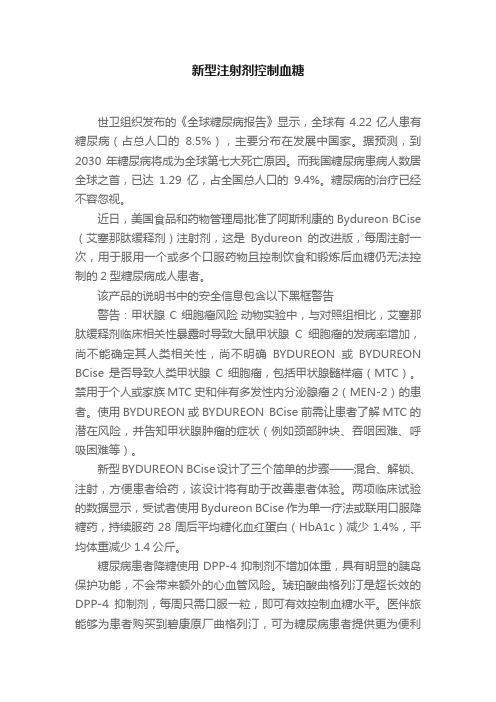
新型注射剂控制血糖世卫组织发布的《全球糖尿病报告》显示,全球有4.22亿人患有糖尿病(占总人口的8.5%),主要分布在发展中国家。
据预测,到2030年糖尿病将成为全球第七大死亡原因。
而我国糖尿病患病人数居全球之首,已达1.29亿,占全国总人口的9.4%。
糖尿病的治疗已经不容忽视。
近日,美国食品和药物管理局批准了阿斯利康的Bydureon BCise (艾塞那肽缓释剂)注射剂,这是Bydureon的改进版,每周注射一次,用于服用一个或多个口服药物且控制饮食和锻炼后血糖仍无法控制的2型糖尿病成人患者。
该产品的说明书中的安全信息包含以下黑框警告警告:甲状腺C细胞瘤风险动物实验中,与对照组相比,艾塞那肽缓释剂临床相关性暴露时导致大鼠甲状腺C细胞瘤的发病率增加,尚不能确定其人类相关性,尚不明确BYDUREON或BYDUREON BCise是否导致人类甲状腺C细胞瘤,包括甲状腺髓样癌(MTC)。
禁用于个人或家族MTC史和伴有多发性内分泌腺瘤2(MEN-2)的患者。
使用BYDUREON或BYDUREON BCise前需让患者了解MTC的潜在风险,并告知甲状腺肿瘤的症状(例如颈部肿块、吞咽困难、呼吸困难等)。
新型BYDUREON BCise设计了三个简单的步骤——混合、解锁、注射,方便患者给药,该设计将有助于改善患者体验。
两项临床试验的数据显示,受试者使用Bydureon BCise作为单一疗法或联用口服降糖药,持续服药28周后平均糖化血红蛋白(HbA1c)减少1.4%,平均体重减少1.4公斤。
糖尿病患者降糖使用DPP-4抑制剂不增加体重,具有明显的胰岛保护功能,不会带来额外的心血管风险。
琥珀酸曲格列汀是超长效的DPP-4抑制剂,每周只需口服一粒,即可有效控制血糖水平。
医伴旅能够为患者购买到碧康原厂曲格列汀,可为糖尿病患者提供更为便利的选择,使患者的生活质量得到了极大的改善。
糖尿病一旦控制不好会引发并发症,导致肾、眼、足等部位的病变。
- 1、下载文档前请自行甄别文档内容的完整性,平台不提供额外的编辑、内容补充、找答案等附加服务。
- 2、"仅部分预览"的文档,不可在线预览部分如存在完整性等问题,可反馈申请退款(可完整预览的文档不适用该条件!)。
- 3、如文档侵犯您的权益,请联系客服反馈,我们会尽快为您处理(人工客服工作时间:9:00-18:30)。
核准日期:年月日艾塞那肽注射液说明书请仔细阅读说明书并在医师指导下使用对艾塞那肽及其它成份过敏者禁用【药物名称】通用名称:艾塞那肽注射液英文名称:Exenatide Injection汉语拼音:Aisainatai Zhusheye【成份】本品主要成份为艾塞那肽。
化学结构式:分子式:C184H282N50O60S分子量:4186.6辅料:甘露醇、醋酸钠三水合物、间甲酚(2.00-2.4mg/ml)、冰醋酸、注射用水。
【性状】本品为无色澄明液体【适应症】本品用于改善2型糖尿病患者的血糖控制,适用于单用二甲双胍、磺酰脲类,以及二甲双胍合用磺酰脲类,血糖仍控制不佳的患者。
【规格】(1)5μg剂量刻度注射笔:0.25 mg/ml,1.2 ml/支,单次注射药量5μg,内含60次注射的药量。
(2)10μg剂量刻度注射笔:0.25 mg/ml,2.4 ml/支,单次注射药量10μg,内含60次注射的药量。
【用法用量】本品的起始剂量为每次5微克(μg),每日2次,在早餐和晚餐前60分钟内(或每天的2顿主餐前;给药间隔大约6小时或更长)皮下注射。
不应在餐后注射本品。
根据临床应答,在治疗1个月后剂量可增加至10微克。
每日2次。
每次给药应在大腿、腹部或上臂皮下注射给药。
本品推荐用于接受二甲双胍、一种磺酰脲类、二甲双胍合用一种磺酰脲类治疗,血糖仍控制不佳的2型糖尿病患者。
在二甲双胍治疗的基础上加用本品时,可继续使用二甲双胍的目前剂量,因为合用本品发生低血糖而需要进行调整二甲双胍剂量的可能性较低。
在磺酰脲类治疗基础上加用本品,应该考虑降低磺酰脲类的剂量,以降低低血糖发生的风险。
(参照【注意事项】,低血糖)本品为无色澄明液体,当溶液有颗粒、浑浊或变色时不得使用。
过有效期后不得使用。
尚无本品静脉或肌肉注射的安全性和有效性资料。
注射笔使用指南注射笔的详细操作图示和注射指导请参见本品包装盒中所附“注射笔使用手册”。
重要提示使用本注射笔前请仔细阅读“注射笔使用手册”,如果不完全按照使用手册操作可能会出现剂量错误、注射笔损坏或者发生感染。
·每次使用前请检查注射笔上的标签,确认其为自己所用的5μg或10μg注射笔。
·每支新笔第一次使用前,必须按照新笔设置的要求进行设置。
此设置仅在新笔第一次使用前进行。
·如果注射笔有任何部分的破裂或损坏,则不得使用。
·不推荐盲人或视力损伤者使用本注射笔。
如需使用应在接受过本品培训的人的帮助下使用。
·不得将此本品的注射笔中的药液移到其他注射器或药瓶中使用·确认本品笔芯中的药液是澄明、无色且无颗粒物。
如果不是,则不得使用。
·请按照医务人员推荐的无菌注射技术进行操作。
·注射笔从第1次设定后最多可用30天。
首次使用至30天后,既使用笔内尚余药液,也应丢弃。
当开始使用艾塞那肽注射笔时,请将第1次使用的日期和30天后的日期记录在使用手册的空白处。
注射笔特点·预装注射笔内含有60次皮下注射的药量,可供30天使用。
·对5μg注射笔每次注射剂量固定为5微克,对10μg注射笔每次注射剂量固定为10微克。
针头·本品包装盒内无注射笔针头。
注射笔可使用:-29(细)、30或31(更细)号规格的一次性针头。
请询问医生何种型号和长度的针头合适您使用。
·每次注射都应使用新针头。
每次注射完成后均应移除针头以防止艾塞那肽注射液泄露,也可防止产生气泡、减少针头堵塞而将感染的风险减到最低。
·不得与他人共用你的注射笔或针头。
·使用前一定要确认针头牢固地安装在注射笔上。
针头未安装好之前不得按注射按钮。
·使用过的针头弃于放锐器用的容器中或按医生的要求妥善处理。
不得将注射笔在带有针头时丢弃。
·医生及医务工作者应按当地要求或管理规定处理注射针头。
清洁·如果需要,可以用一块干净、潮湿的布擦拭注射笔的表面。
·在正常使用过程中,注射笔芯顶部的外侧可能会出现一些白色的颗粒。
可以用酒精纱布或酒精棉签擦去。
【不良反应】临床研究数据与二甲双胍、一种磺酰脲类或二者合用*数据来源于3项30周安慰剂对照临床试验(艾塞那肽组N=963)艾塞那肽与一种磺酰脲类合用,或艾塞那肽与二甲双胍及一种磺酰脲类合用,与对照组(安慰剂合用磺酰脲,或安慰剂合用一种磺酰脲及二甲双胍)相比低血糖的发生率增加,并表现出与艾塞那肽和磺酰脲类呈剂量依赖性。
大多数低血糖的程度为轻到中度,可通过口服碳水化合物缓解。
(见【注意事项】)为减少与磺酰脲类合用时发生低血糖的风险,应考虑降低磺酰脲类药物的原有剂量。
(见【用法用量】)然而,本品与二甲双胍何用时,相对于安慰剂合用二甲双胍对照组,低血糖的发生率并未升高。
报告的最常见的不良反应为具有剂量依赖性的轻度到中度恶心。
大多数治疗开始时出现恶心的患者,症状的发生频度和严重程度会随着继续治疗时间的延长而减轻。
在30周安慰剂对照研究中,患者因不良反应事件退出临床试验的发生率在艾塞那肽治疗组为7%,而在安慰剂组为3%。
导致艾塞那肽治疗组患者退出试验的最常见不良反应为恶心(占3%)和呕吐(占1%);在安慰剂组,<1%的患者因恶心退出试验,0%因呕吐退出试验。
在52周的开放延长试验中所观察到的不良事件类型与30周对照试验中所观察到的相似。
自发报告自本品上市以来,报告了下述其它的不良反应:胃肠道不适:腹胀、腹痛、嗳气、便秘、胃肠胀气(少见),急性胰腺炎(罕见)。
(见【注意事项】)一般状况和注射部位反应:注射部位反应(常见)。
变态反应:过敏反应(非常罕见)。
研究发现:合用华法林时INR升高且有些报告伴有出血。
(见【注意事项】及【药物相互作用】)代谢和营养异常:脱水(罕见),通常伴有恶心、呕吐和/或腹泻,体重减轻。
(见【注意事项】)神经系统异常:味觉障碍(少见),嗜睡(罕见)。
皮肤和皮下组织异常:瘙痒症和/或荨麻疹、斑丘疹、血管性水肿(罕见)、脱发(罕见)。
肾及尿路异常:肾功能改变,包括急性肾功能衰竭、慢性肾功能衰竭恶化、肾功能损伤、血清肌酐升高(罕见)。
(见【注意事项】)免疫原性与蛋白和多肽药物的潜在免疫原性特征一致,在接受本品治疗后,患者可能产生抗艾塞那肽抗体。
大多数产生抗体的患者,其抗体滴度随时间延长而降低。
在安慰剂对照临床试验中,治疗30周时38%患者产生了低滴度的抗艾塞那肽抗体。
这组患者血糖控制(HbA1c)水平通常与无抗体滴度患者的相似。
治疗30周时,另有6 %的患者产生较高的抗体,其中约一半(在30周对照试验中为艾塞那肽组患者的3%)患者的血糖对本品应答反应衰减; 其余患者的血糖应答与未产生抗体的患者相似。
【禁忌】本品禁用于对艾塞那肽或本品其其它成分过敏的患者。
【注意事项】对于胰岛素依赖患者本品不可以替代胰岛素。
本品不适合1型糖尿病患者或糖尿病酮酸中毒的治疗。
接受本品治疗的患者在上市后报告中有急性胰腺炎的病例,应告知患者剧烈的腹痛并有可能伴有呕吐是急性胰腺炎的典型症状。
一旦疑似胰腺炎,应停止使用本品及其它可疑的药物,同时进行确诊检查及适时的治疗。
对确诊为胰腺炎但并未确定由其它原因引起的胰腺炎,不推荐恢复使用本品。
不推荐本品用于终末期肾脏疾病或严重肾功能不全(肌苷清除率<30ml/min)患者。
接受透析的终末期肾脏疾病患者,由于胃肠道不良反应,不能很好地耐受单剂量5微克本品。
尚未进行本品在严重胃肠道疾病(包括胃轻瘫)患者中的研究。
本品通常可引起为肠道不良反应,包括恶心、呕吐和腹泻。
因此,不推荐本品用于严重胃肠道疾病患者。
本品对18岁以下患者的安全性和有效性尚未确立。
(参见【药代动力学】)尚未进行本品与胰岛素、D-苯丙氨酸衍生物、氯茴苯酸类、a-葡萄糖苷酶抑制剂、普兰林态(amylinomimetics)或二肽基肽酶IV抑制剂(dipeptidyl peptidase-4 inhibitors)合用的研究已有罕见的自发报告有肾功能改变,包括血清肌酐升高,肾功能损伤,慢性肾功能衰竭恶化和急性肾功能衰竭,有些需要血液透析。
部分上述情况发生在接受一种或多种影响肾功能/水化状态的药理学制剂和/或出现恶心、呕吐/腹泻这些可能影响水化状态症状的患者中。
合用药物包括血管紧张素转化酶抑制剂,非甾体抗炎药和利尿药。
停止使用产生潜在病因的药物(包括艾塞那肽)并给予支持性治疗,观察到肾功能改变可以逆转。
在临床前和临床研究中未见艾塞那肽对肾脏有直接危害。
(参见【不良反应】中“自发报告”)罕见急性胰腺炎的自发报告。
应告知患者急性胰腺炎的典型症状:持续、剧烈的腹痛。
并且一旦疑似为胰腺炎,应停止使用艾塞那肽。
给予支持性治疗后胰腺炎可治愈,但有非常罕见的病例出现胰腺坏死、出血性胰腺炎和/或死亡。
如果确诊为胰腺炎,不推荐恢复使用艾塞那肽。
自本品上市以来,有一些关于华法林和本品合用后出现INR(国际标准化比率)升高、有时伴有出血的自发报告。
(参见【药物相互作用】及【不良反应】)艾塞那肽治疗的患者中,有报告体重快速减轻每周超过1.5Kg的事件。
这种体重减轻的程度可能会产生有害的后果。
低血糖与安慰剂合用磺酰脲类相比,本品合用磺酰脲类低血糖发生率升高。
为了降低本品合用磺酰脲类发生低血糖的风险,可考虑减少磺酰脲类药物的剂量。
(参见【用法用量】)然而,与安慰剂合用二甲双胍相比,未观察到本品合用二甲双胍后低血糖的发生率增高。
与安慰剂合用噻唑烷二酮类相比,本品合用噻唑烷二酮类后低血糖的发生率相似。
当本品作为单一疗法使用时,低血糖的发生率为5%,而安慰剂为1%.在健康志愿者的随机、双盲、对照研究中,本品不会改变反调节激素对胰岛素诱发的低血糖的应答。
对驾驶和操作机器的影响当艾塞那肽与磺酰脲类药物合用时,应告知患者在驾驶或操作机器时采取必要措施防止发生低血糖。
【孕妇及哺乳期妇女用药】妊娠根据AUC,当小鼠的全身暴露量为人体最大推荐剂量(20微克/天)暴露量的3倍时,艾塞那肽可能造成小鼠胚胎和新生仔生长迟滞及骨骼效应。
,根据AUC,当兔全身暴露量(AUC)相当于人体最大推荐剂量(20微克/天)暴露量的12倍时,艾塞那肽可能造成兔骨骼效应。
尚无妊娠妇女的足够资料和良好的对照临床研究。
因此,只有本品对胎儿的潜在益处大于潜在风险时,才考虑妊娠期间使用本品。
雌性小鼠从交配前2周开始至交配再至妊娠第7天,皮下注射剂量6 、 68 或760 微克/公斤/天的艾塞那肽,即使剂量高达760微克/公斤/天,根据AUC,全身暴露量为人体最大推荐剂量(20微克/天)暴露量的390倍时,亦未见胚胎毒性效应。
在小鼠妊娠的第6天到15天(器官发生期),皮下注射剂量6 、68 、460 、760微克/公斤/天的艾塞那肽,在6微克/公斤/天剂量组,观察到腭裂(有些伴有缺口)以及不规则的肋骨和颅骨的骨化,根据AUC,此全身暴露量相当于人体最大推荐剂量(20微克/天)暴露量的3倍时。
